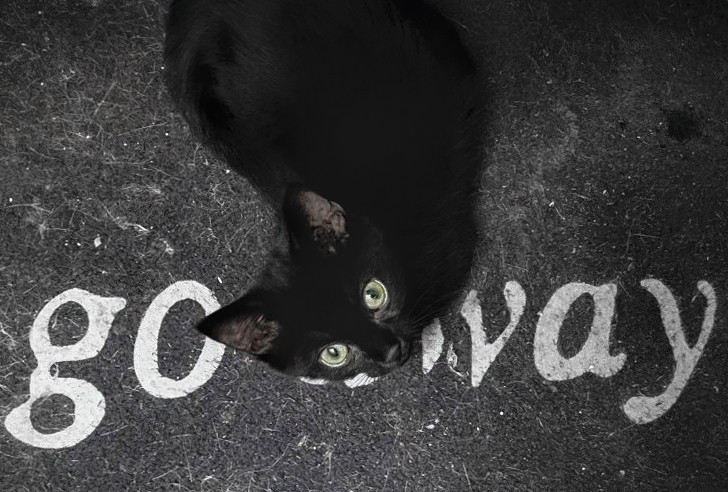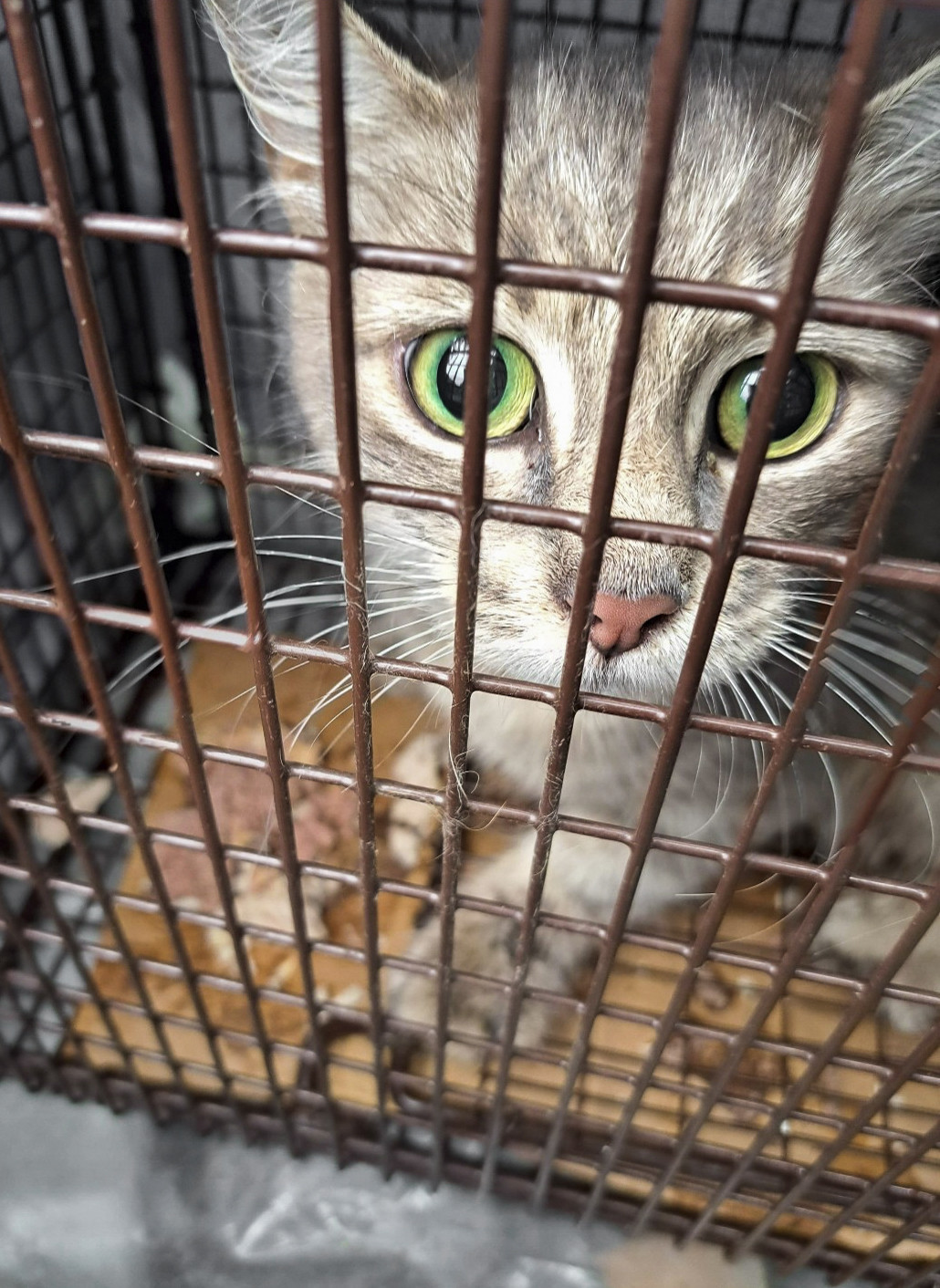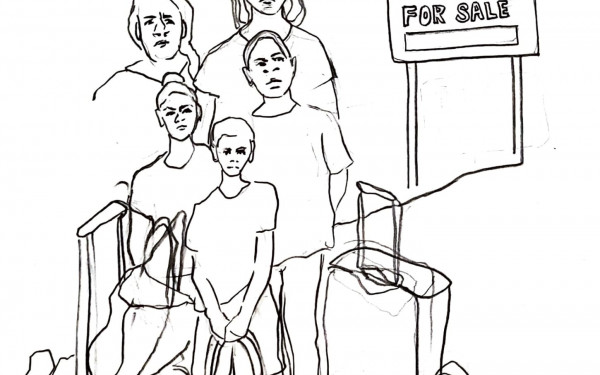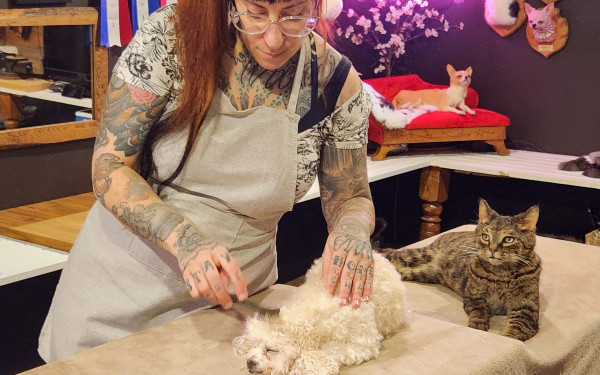Parc-Extension’s Whisker Whisperer
Lady Gatta has saved countless cats in her time as a rescuer. Courtesy Nadia Verrucci
Meet Lady Gatta, the Cat Rescuer Fostering Change in her Community
A petite woman in an electric blue coat was sitting in a similarly vibrant blue hatchback, speaking into her phone’s microphone, cradling it like a walkie-talkie.
Nadia Verrucci, Park-Extension’s cat trapper extraordinaire, was speaking to neighbourhood resident Gina Calandriello. A week prior, Calandriello had been taking care of a cat who had recently given birth in her front yard. Verrucci’s instructions are simple: get the tuna and treats ready.
“Please, don’t throw away the tuna juice, period,” Verrucci said.
A short drive later, she stopped at a two-story rowhouse. Barely two steps from its front door was another home: a makeshift animal shelter—an amalgamation of wooden boards and blankets held together by thin rope. Propped on top of the shelter was a small portrait of a cat in front of a pink background. From a balcony above hung a ball on a long piece of string, a free-for-all cat toy.
“Here’s the strategy,” Verrucci said, as she approached Calandriello in her front yard. Pulling out her instruments of cat capture, mainly a trapping cage and a big bottle of water attached to a ball of yarn, Verrucci methodically set the stage. By the end of it, she would hopefully have a mother and newborn kittens safely in her custody.
She scattered the tuna in a trail leading up to the cage. Then, in what she called the bottle method, she propped open the door with the bottle and retreats, ready to pull the yarn and trap the mother cat. Her kittens would be easy to fetch after this critical step.
This was but one of the many requests Parc-Ex’s one-woman cat rescue team receives in her day-to-day. Some come from the 400 or so followers of her Facebook page, Lady Gatta Cat Rescue and Adoption—the word gatta meaning female cat in Italian.
Verrucci had already been in the line of cat rescuing for five years before starting the page in June 2021. It all started when Canadian actor Leni Parker, a friend of Verrucci, told her of the non-profit organisation Parker had helped found: The Pussy Patrol Cat Rescue.
Having had cats by her side since early childhood, Verrucci was immediately intrigued. After learning the ins and outs of cat trapping with Parker, she began doing it herself.

“It’s all grassroots, it’s all just people like me who have freakin’ jobs and all in our spare time are doing all of the work, and that’s really frustrating.” — Nadia Verrucci
Cat rescuing is by no means the only thing on her plate: Lady Gatta is also a full-time elementary school teacher and actor. Still, she continues her work, despite facing the burnout she says many cat rescuers eventually fall victim to. She gains not a dime from this work.
“Nobody who does trapping and rescue does it as a business," said Verrucci. "Everybody loses money, everybody puts out of their own pocket 100 per cent.”
She explained that everyone involved, from trappers, to foster parents, to those who simply leave out food for cats in their backyards, often pay for all supplies—food, litter, cages, toys, veterinarian bills—themselves.
Parc-Extension has long been facing a stray cat conundrum. Estimates place the community’s stray cat population in the several hundreds. And in the summertime, particularly due to the moving season, the high rate of abandoned cats bumps up those numbers.
In recent efforts to amend the problem, the Society for the Prevention of Cruelty to Animals started a petition to end the no-pets clauses in Quebec rental leases. According to the organization, this disproportionately impacts low-income renters who already have fewer housing opportunities. Finding a pet-friendly apartment for rent is difficult in Montreal, and is often more expensive.
Serving as the primary cat trapper for a lower-income area like Parc-Extension, Verrucci has built a network of contacts who are tapped into the neighbourhood’s several cat colonies. A cat colony describes any free-roaming group of cats that live together in a particular area.
“Cats are very territorial," said Verrucci. "They hang out in a two to three-block radius, they tend to go back to the same spot all the time to eat or to sleep.”
Stray cats’ only saving grace, particularly in the harsh winters, is their human neighbours. Like Calandriello, they not only leave out food and water, but also build makeshift shelters, lay down blankets and leave out toys for them.
"People have this misconception that cats love being outside and cats are supposed to be outside," said Verrucci, "and that’s completely ridiculous, it's -40 C out there. Nobody wants to be outside.”
Parc-Extension's cats aren’t only fighting the harsh elements. Rescuers would frequently recall an incident from August 2021 where a Parc-Extension cat was believed to have been shot dead with a pellet gun. The police were called in, but did not confirm the cause of the cat's death. Other incidents involving cats shot with pellet guns are not a rarity in Montreal.
To Verrucci, the biggest culprit of exploding stray cat populations is a lack of sterilization.
"More often than not, there's some nice person who is just feeding the cats. People don't often think about sterilizing them, which is where the whole problem is, because that's thousands of cats every year just popping out,” explained Verrucci.
This is where the Montreal SPCA and its Trap-Neuter-Release-Maintain program comes in.
Cats and the TNRM
"It’s a well-known fact: cats multiply at a very high rate," states the opening paragraph on the SPCA's TNRM program webpage. "An unsterilised female can give birth to three litters of at least four kittens every year."
Individuals who want to take part in this program must live in a municipality partnered with the SPCA and obtain a mandatory permit from the city, which is what Verrucci has. The story then often goes like this: Verrucci receives a call or a message informing her of a Parc-Extension resident sustaining cats around their home.
The number can range from a few to over 10, and, as Verrucci once witnessed, could reach up to 30 cats. After receiving the initial call, she promptly contacts the individual, arranges a visit, then surveys the colony to determine its friendliness level.
Next, Verrucci sets up a plan—a formula she has come to master in the past six years.
“You have to get the person who's feeding to feed the cats at very specific times of the day,” detailed Verrucci, adding that they should be fed in precisely the same location. “Usually, right away in the morning or around dinnertime at night.”
A few days later, Verrucci sets up a trap in that location and asks the feeder to place the food inside the cage. The same routine is repeated over the course of a week as the cats get used to the presence of the cage.
On the day of trapping, the feeder is asked not to feed the cats, as their hunger increases the likelihood of them entering the cage. Verrucci then waits outside near the cage for 10 minutes, an hour, or several hours depending on the cat. She waits through snow, rain or shine—no matter the season. Once the cat is trapped in the cage, a cover or a blanket must be thrown over the cage as fast as possible.
“If you don’t, the cats panic and they freak out and they slam against the cage and they can really, really hurt themselves," explained Verrucci. "But as soon as you throw a cover over the top, they just calm down immediately. It’s very fascinating.”
Unless they are between two and four months of age, in which case they are too young for sterilization, Verrucci then takes the cats to the Mittens-Montreal SPCA Targeted Permanent Sterilization Clinic, where they are sterilized, vaccinated, dewormed, and given a flea treatment. The cat then undergoes an ear-tipping, where an ear is clipped to signify its sterilization.
Her final step is to return the cats to their original location and release them. From that point forward, the Maintain portion of TNRM falls on the colony's original feeders to continue feeding the cats and providing shelter.
However, Verrucci's duties often extend beyond that, and are far more complicated than simply releasing cats back outdoors.

Stray vs. Feral Cats
Once sterilization is complete, Verrucci, like many other cat rescuers, breaks with the trajectory set out in the TNRM program. While the SPCA typically re-releases sterilised cats into their original territory, independent cat rescuers often object to this practice. This is due to a very important distinction: the terms "stray" and "feral" are not interchangeable.
A stray cat is one that has been abandoned or previously owned, and is often friendly due to it having received a fair amount of human socialization. The high incidence of friendly cats outdoors is usually the result of pet owners letting their cats roam without a collar or microchip. There are also those who abandon their house cats on July 1, Quebec’s moving day.
A feral cat is one that has had rare interactions with humans and is therefore nearly impossible to socialize. Most of the cats Verrucci rescues do not fall into this category. Unfortunately, the SPCA is known for returning many socialized cats back onto the street; cats that rescuers believe can and should be fostered and adopted.
After sterilization, Verrucci scours groups on Facebook for anyone willing to foster her rescued cats. Finding a foster can be quite difficult, a process only slightly eased at the height of the pandemic. If a foster can’t be found, Verrucci may take it upon herself, as she once did with a mother cat and her two newborns.
“I took the mother and the two kittens and they lived in my closet,” she said. “This was necessary,” Verrucci explained, considering the unfriendly dispositions of her own two cats, Pants and Julio.
One of Verrucci’s go-to fosters is Marie-Josée Nantel, who believes Lady Gatta’s work constitutes a very positive story coming out of Parc-Extension.
"Instead of seeing a problem and complaining about it in the neighbourhood, [Verrucci] is seeing a problem and she's working very hard to try and fix it," said Nantel.
Fostering involves a lot of interactions on the part of Verrucci even after a foster has been found, as Nantel laughingly described a situation where a kitten she was fostering had diarrhea. Recalling the event, Nantel put it bluntly: “There’s poop everywhere!”
"And I call Nadia, 'Nadia help me!' And she said, 'Okay, can I come tomorrow morning?' And I said, 'Well, it's everywhere!'," said Nantel. "She said, 'Okay, okay, I'll go to the vet right now, I'll buy the special food, and I'll bring it to your house.’”
Eventually, Verrucci finds an individual interested in adoption, and the cat settles into its forever home. The process is tedious, though many cat advocates believe it is necessary and should be a responsibility of the SPCA. Consequently, this has created a love-hate relationship between the organization and Parc-Extension’s cat rescuers.
On the topic of TNRM in an interview with Parc-Extension News, Montreal SPCA Executive Director Élise Desaulniers defended the program and its efficiency, explaining that its ultimate goal is to reintroduce cats to their habitat.
“It’s a technique that has shown in other cities around North America that it is the most efficient way to reduce the population of feral cats,” said Desaulniers.
“What we realize also is that putting a cat in a cage at the SPCA so people can adopt them is not always the best thing to do for the cat welfare,” added Desaulniers. The reason for this is the lack of homes willing to adopt these cats.
Consequently, the SPCA rationalizes the TNRM program as the most humane way to tackle the dilemma.
“When she says she’s going to be there, she’s there, and it’s not about her: it’s about the cats.” — Marie-Josée Nantel

Cats vs. The Government
Though cat rescuers believe the SPCA still has a lot more to do, many in Parc-Extension have cause to celebrate. The efforts of the borough’s cat rescuers and cat fanatics alike are directly responsible for the existence of TNRM in their neighbourhood. The program is not available in boroughs whose municipalities will not pay the SPCA for the service.
"We had to fight to get that, we had to go to the council meetings more than once to get them to even give money to the SPCA for the TNRM program," said Verrucci.
She believed the municipality's help should reach beyond providing funds to the SPCA. "It’s all grassroots, it’s all just people like me who have freakin’ jobs and all in our spare time are doing all of the work," said Verrucci. "And that’s really frustrating.”
When asked why one of the city's poorest neighbourhoods should care about cats along with its many other issues, Verrucci had two responses to government officials.
The first was purely emotional: "How could you not give a crap about living creatures?”
The second was pragmatic—she explained that she would convince city councillors that a large amount of stray cats could negatively impact property values.
“People don’t have any idea how bad the stray cat problem is. The government does absolutely nothing about it, they should be so incredibly ashamed of themselves,” said Verrucci. “[Montreal Mayor] Valérie Plante jumped through hoops to get the calèche horses off the streets, but she does absolutely nothing for the stray cat population.”
Back in Calandriello’s front yard, after several hours of waiting for the mother cat to unsuccessfully enter the trapping cage, Lady Gatta cornered her in the makeshift shelter with her kittens, taping a piece of cardboard over its entrance. Then, she loaded the entire structure into the back of her small car.
“I’m an expert at making room,” she said.
"When she says she's going to be there, she's there," said Nantel. "And it's not about her: it's about the cats."




